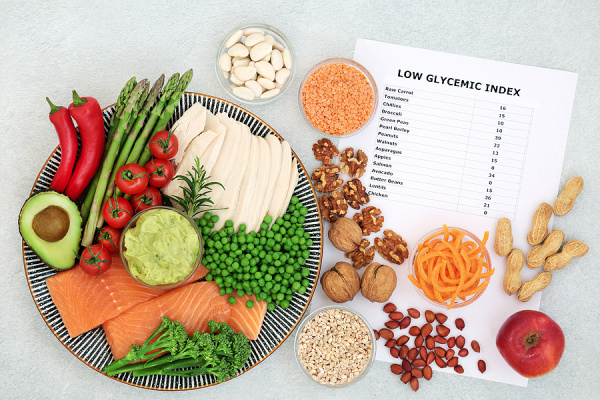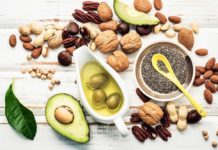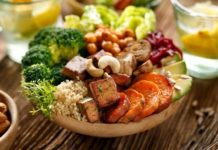
Hypoglycemia, also known as low blood sugar, can cause shakiness, irritability and anxiety. While it’s commonly associated with diabetes, it’s possible to experience hypoglycemia without diabetes. If you have symptoms of hypoglycemia, it’s important to monitor the glycemic index (GI) of the foods you eat and alter your diet if necessary. Keep reading to learn more about the hypoglycemia diet and foods to eat and avoid to keep your symptoms in check.
What is Hypoglycemia?
Hypoglycemia is a condition in which your blood sugar (glucose) levels are too low. Although it’s more common in people who have diabetes, it can also occur in people who do not have diabetes. It happens in people with diabetes if the body produces too much insulin. If you don’t have diabetes, hypoglycemia can occur if your body can’t stabilize your blood sugar levels. It can also happen if your body produces too much insulin after meals.
Glucose is the main source of energy for your body and brain. Insulin helps keep blood glucose at normal levels so your body can work properly. Insulin helps glucose enter your cells where it’s used for energy, and if your glucose levels are too low, it can lead to hypoglycemia.
What Are the Symptoms of Hypoglycemia?
Symptoms of hypoglycemia can range from minor to severe.
Minor symptoms include:
- Dizziness
- Shakiness
- Sweating
- Hunger
- Headaches
- Anxiousness
- Inability to concentrate
- Irritability
- Drowsiness
- Exhaustion
More severe symptoms include:
- Muscle weakness
- Slurred speech
- Blurry vision
- Consistent drowsiness
- Seizures
- Fainting and unconsciousness
- Heart palpitations
- Turning pale
What Causes Hypoglycemia?
Hypoglycemia is defined as blood sugar below 70 milligrams per decilitre (mg/dL) or 3.9 millimoles per litre (mmol/L).
Hypoglycemia With Diabetes
For those with diabetes, hypoglycemia occurs when there’s too much insulin and not enough glucose in the blood. Causes include:
-
- not eating or skipping meals
- drinking alcohol without food
- taking too much insulin
- increasing physical activity
Hypoglycemia Without Diabetes
If you don’t have diabetes, hypoglycemia can occur due to factors such as:
- binge drinking
- liver disease
- eating disorders
- hormonal deficiencies
- malnutrition
- excessive exercise
- hypothyroidism
- hemodialysis
You’re at an increased risk of developing hypoglycemia if you have other health problems, are obese, have family members with diabetes or have pre-diabetes.
There are two types of non-diabetes hypoglycemia:
- Reactive hypoglycemia occurs within 4 hours following a meal. The exact cause is unknown, but it often relates to variations in your diet, such as the time of day you eat.
- Non-reactive hypoglycemia isn’t typically related to food, but may be a result of an underlying condition such as heavy drinking, eating disorders or chronic illnesses like liver, heart and kidney disorder.
What is a ‘Hypoglycemia Diet’?
If you have hypoglycemia, you can help manage your systems through your diet. Rather than 3 large meals per day, eat small meals every 3 to 4 hours throughout the day and avoid foods high in saturated or trans fats. Try to eat your first meal as soon as you wake up, as your blood sugar levels may have dropped during the night. You can also avoid symptoms by making sure to always carry a snack with you so your blood sugar levels don’t drop.
While there isn’t a specific diet for hypoglycemia, modifying your diet can help with your symptoms. Make sure to eat a variety of foods, including protein, fatty foods and high fibre foods, and limit high sugar and processed foods. If you have hypoglycemia, you should be aware of the glycemic index or GI of foods you eat. Some healthy foods may have a high GI.
Foods to Eat on a Hypoglycemia Diet
- Fruits like berries, apples, banana, apricots, cantaloupe, mango, orange, peach, pear, plum, pomegranate
- Vegetables such as dark leafy greens, sweet potato, peas, winter squash,
- Beans and lentils including chickpeas, kidney beans, mung beans, edamame and split peas
- Lean protein like chicken, meat and fish
- Eggs
- Foods high in soluble fibre such as black beans, avocados, broccoli and kidney beans
- Complex carbohydrates including brown rice, oats, vegetables, legumes and nuts
- Greek yogurt and frozen yogurt
- Almond milk and soy milk
- 1% and 2% cow’s milk
- Spelt bread
- Sourdough bread
- Nuts and nut butter
- Tofu
- hole grain tortillas
- ll-bran and oat bran cereals
- Steel cut oats
- Alternative sweeteners such as Stevia
Foods to Avoid on a Hypoglycemia Diet
- Processed foods like cheese, bacon, canned vegetables, deli meat, cakes, cookies, and microwave meals
- White and whole wheat bread
- Jasmine rice or instant white rice
- Foods with refined sugars such as
- Starches like pretzels, rice cakes and soda crackers
- Simple carbohydrates including candy, sugary drinks, baked goods, sugary cereals
- Caffeine
- Alcohol
- Fruit juice
30 Hypoglycemia Diet Recipes
- Spiced Cauli Paleo Breakfast Bowl | Maria Marlowe
- Simple Poached Egg and Avocado Toast | Pinch of Yum
- Jerk Sweet Potato and Black Bean Curry | BBC Good Food
- Spinach Quiche Cups | Manila Spoon
- Arugula and Crisped Prosciutto Egg Sandwich | Food for My Family
- Egg and Bean Breakfast Burritos | Diabetes.org
- Smoked Haddock with Lemon and Dill Lentils | BBC Good Food
- Tomato and Zucchini Frittata | SkinnyTaste
- Zucchini Bake | Christine’s Cozy Corner
- Low GI Breakfast Bowl | Food By Maria
- Healthy Chicken Lettuce Wraps | The Toasted Pine Nut
- Chocolate Peanut Butter Smoothie | Fifty 50 Foods
- Avocado Tuna Salad on Apple Slices | My Fitness Pal
- Chicken Fried Rice | Food.com
- BBQ Chicken Spaghetti Squash Boats | The Toasted Pine Nut
- Maple Glazed Chicken Thighs | Fifty 50 Foods
- Antipasto Toastie | GI Symbol
- Easy Low Carb Oatmeal | Diabetes Strong
- Apricot Granola with Pinoli Nuts | Fifty 50 Foods
- Spiced Cauliflower and Green Romesco | The Toasted Pine Nut
- Golden Overnight Oats with Blueberries | My Fitness Pal
- Asparagus, Corn and Brazil Nut Salad | GI Symbol
- Artichoke Chicken Bake | Kalyn’s Kitchen
- Fish with Herbed Chickpea Puree | Taste
- Low GI Chocolate Chip Cookies | Spark Recipes
- Easy Baked Tilapia | All Recipes
- Mexican Baked Eggs | Kalyn’s Kitchen
- Layered Chicken, Lemon and Risoni Bake | Taste
- Ginger Glazed Mahi Mahi | All Recipes
- Steamed Ginger Fish with Gai Lan | Taste
If you have hypoglycemia, use these tips and recipes to manage your symptoms and feel better all around.
















